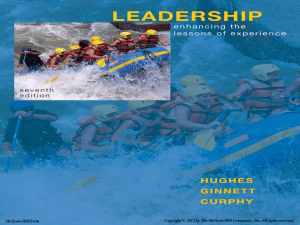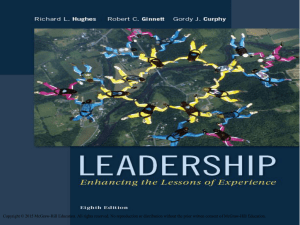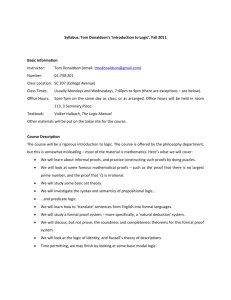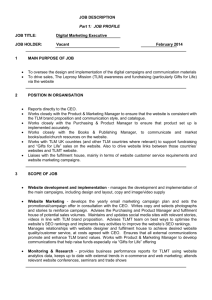TLM – THE SWISS 3D TOPOGRAPHIC LANDSCAPE MODEL
advertisement
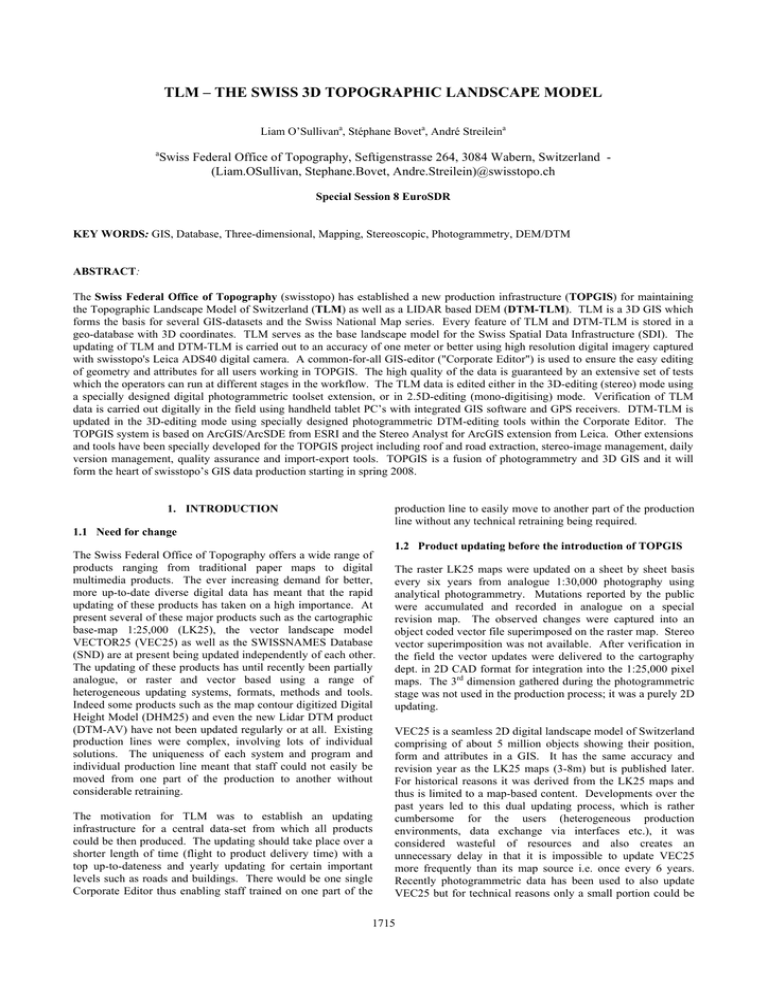
TLM – THE SWISS 3D TOPOGRAPHIC LANDSCAPE MODEL Liam O’Sullivana, Stéphane Boveta, André Streileina a Swiss Federal Office of Topography, Seftigenstrasse 264, 3084 Wabern, Switzerland (Liam.OSullivan, Stephane.Bovet, Andre.Streilein)@swisstopo.ch Special Session 8 EuroSDR KEY WORDS: GIS, Database, Three-dimensional, Mapping, Stereoscopic, Photogrammetry, DEM/DTM ABSTRACT: The Swiss Federal Office of Topography (swisstopo) has established a new production infrastructure (TOPGIS) for maintaining the Topographic Landscape Model of Switzerland (TLM) as well as a LIDAR based DEM (DTM-TLM). TLM is a 3D GIS which forms the basis for several GIS-datasets and the Swiss National Map series. Every feature of TLM and DTM-TLM is stored in a geo-database with 3D coordinates. TLM serves as the base landscape model for the Swiss Spatial Data Infrastructure (SDI). The updating of TLM and DTM-TLM is carried out to an accuracy of one meter or better using high resolution digital imagery captured with swisstopo's Leica ADS40 digital camera. A common-for-all GIS-editor ("Corporate Editor") is used to ensure the easy editing of geometry and attributes for all users working in TOPGIS. The high quality of the data is guaranteed by an extensive set of tests which the operators can run at different stages in the workflow. The TLM data is edited either in the 3D-editing (stereo) mode using a specially designed digital photogrammetric toolset extension, or in 2.5D-editing (mono-digitising) mode. Verification of TLM data is carried out digitally in the field using handheld tablet PC’s with integrated GIS software and GPS receivers. DTM-TLM is updated in the 3D-editing mode using specially designed photogrammetric DTM-editing tools within the Corporate Editor. The TOPGIS system is based on ArcGIS/ArcSDE from ESRI and the Stereo Analyst for ArcGIS extension from Leica. Other extensions and tools have been specially developed for the TOPGIS project including roof and road extraction, stereo-image management, daily version management, quality assurance and import-export tools. TOPGIS is a fusion of photogrammetry and 3D GIS and it will form the heart of swisstopo’s GIS data production starting in spring 2008. production line to easily move to another part of the production line without any technical retraining being required. 1. INTRODUCTION 1.1 Need for change The Swiss Federal Office of Topography offers a wide range of products ranging from traditional paper maps to digital multimedia products. The ever increasing demand for better, more up-to-date diverse digital data has meant that the rapid updating of these products has taken on a high importance. At present several of these major products such as the cartographic base-map 1:25,000 (LK25), the vector landscape model VECTOR25 (VEC25) as well as the SWISSNAMES Database (SND) are at present being updated independently of each other. The updating of these products has until recently been partially analogue, or raster and vector based using a range of heterogeneous updating systems, formats, methods and tools. Indeed some products such as the map contour digitized Digital Height Model (DHM25) and even the new Lidar DTM product (DTM-AV) have not been updated regularly or at all. Existing production lines were complex, involving lots of individual solutions. The uniqueness of each system and program and individual production line meant that staff could not easily be moved from one part of the production to another without considerable retraining. The motivation for TLM was to establish an updating infrastructure for a central data-set from which all products could be then produced. The updating should take place over a shorter length of time (flight to product delivery time) with a top up-to-dateness and yearly updating for certain important levels such as roads and buildings. There would be one single Corporate Editor thus enabling staff trained on one part of the 1.2 Product updating before the introduction of TOPGIS The raster LK25 maps were updated on a sheet by sheet basis every six years from analogue 1:30,000 photography using analytical photogrammetry. Mutations reported by the public were accumulated and recorded in analogue on a special revision map. The observed changes were captured into an object coded vector file superimposed on the raster map. Stereo vector superimposition was not available. After verification in the field the vector updates were delivered to the cartography dept. in 2D CAD format for integration into the 1:25,000 pixel maps. The 3rd dimension gathered during the photogrammetric stage was not used in the production process; it was a purely 2D updating. VEC25 is a seamless 2D digital landscape model of Switzerland comprising of about 5 million objects showing their position, form and attributes in a GIS. It has the same accuracy and revision year as the LK25 maps (3-8m) but is published later. For historical reasons it was derived from the LK25 maps and thus is limited to a map-based content. Developments over the past years led to this dual updating process, which is rather cumbersome for the users (heterogeneous production environments, data exchange via interfaces etc.), it was considered wasteful of resources and also creates an unnecessary delay in that it is impossible to update VEC25 more frequently than its map source i.e. once every 6 years. Recently photogrammetric data has been used to also update VEC25 but for technical reasons only a small portion could be 1715 The International Archives of the Photogrammetry, Remote Sensing and Spatial Information Sciences. Vol. XXXVII. Part B4. Beijing 2008 updated in this way and the rest remained dependent on the maps with a resulting updating delay of 2-3 years after the initial aerial photography flights. The result is customers receive already old data which cannot be geometrically improved using the present methods. The database of Swiss-names (SWISSNAMES) has been used for updating the place names in all the Swiss map scales and has therefore also been map based. Importantly the names only have a single geographical reference point. Parallel to this VEC25 has maintained attributes for the same names on some of its objects such as rivers. Therefore data was often collected and maintained in parallel. Field updating has come a long way since analogue maps used to be taken into the field to be verified. Only in the last three years have field topographers been taking vector map updates and VEC25 data with them into the field for verification using mobile GPS handheld devices. 1.3 What needed to be done? The various product updating methods developed independently over the years and slowly started to outlive their usefulness. The dependency of VEC25 and SWISSNAMES on the map updating needed to be uncoupled. It was necessary to eliminate this independent, un-coordinated and parallel updating and replace it by one updating operation from a central data-set from which all products can be derived. Realizing this goal meant that a large part of the present production flow needed to be reversed (see Figure 1). The production of the data could be shortened as the updating can take place independently and more frequently than the 6 year map production cycle. This central data set should be the Topographic Landscape Model (TLM). The project TLM has the goal of creating and maintaining TLM and DTM-TLM for the whole of Switzerland and parts of neighbouring countries up to and including the complete perimeters of the present 1:25,000, 1:50,000 and 1:100,000 maps. Previous process for collecting vector data Topographic Data Collection VECTOR25 Map Production Future process for collecting vector data Topographic Data Collection Map Production Figure 1. Reversing the production process with TLM Although the current map production method, a mix of raster data and CAD, provides excellent graphical results, the updating process is very time consuming and the resulting raster data allows only very limited flexibility for further processing. This production line is also undergoing a parallel revision as part of another ongoing project called OPTINA in which the cartographic maps will be automatically generated from a cartographic database. The project OPTINA is creating the GENIUS-DB (database), which is an ESRI GIS technology and an AXES Systems based automatic generalisation. Both will form the new customised cartographic production system. TLM will supply the base data for the GENIUS-DB cartographic database. 1.4 TOPGIS the infrastructure TOPGIS is a modern database based system comprising of hardware and software for the capture, editing, management, storage and distribution of the TLM. The associated LIDAR based Digital Terrain Model (DTM-TLM) will also be edited using TOPGIS. After a public WTO tender to build the TOPGIS system the bid was won by a consortium led by ESRI Geoinformatik AG Switzerland. The TOPGIS system being built by ESRI and its partners Leica Geosystems, Ernst Basler + Partner, Geocom, Geo7, Trivadis and INSER is now in its version 1.4 stage, version 2 will appear in the autumn of 2008 TOPGIS is completely ArcGIS based including desktop, server, and mobile GIS. It comprises especially build extensions for data capture and management. It has fully integrated photogrammetry through the special development of the extended Stereo Analyst Extension for ArcGIS (SAFA) from Leica. Such a total integration is one of the first in the GIS/Photogrammetry world. Oracle RDBMS and ArcSDE will provide the infrastructure for the central GIS database. ArcGIS Desktop and SAFA are the platforms for the specially developed viewing, digitising and editing environment of TLM and DTM-TLM data. The new mobile field clients will have considerable software enhancements compared to the current Trimble GeoXT/ArcPad combination. At the time of writing the new TOPGIS field client is still in the development stage. Data capture and management is managed by using a system of work-units and release cycles. Work-units are composed of a perimeter and a selection of layers. Each work-unit is assigned to a release cycle. Release cycles will be released about four times per year and include updated data. Throughout the organization the Corporate Editor (CE) has a common look and feel for all tools for editing, manipulating and managing topographic information. A specifically developed Data Dictionary provides functionality for the administrators to centrally manage and configure TOPGIS such as default settings of snapping, viewing, symbology definition, etc. With TOPGIS the infrastructure as well as the all encompassing GIS-functionality for processing and administrating the TLM in a central database has become available. TOPGIS is at the core of swisstopo’s geodata infrastructure and will become the server of GIS data to any number of today’s and future products. TOPGIS is coming into operation in late spring of 2008. When it is fully operational about 50 people will be using the TOPGIS system, of which about 20 of them will be stereo stations. The 1716 The International Archives of the Photogrammetry, Remote Sensing and Spatial Information Sciences. Vol. XXXVII. Part B4. Beijing 2008 next version planned for the end of 2008 will include enhanced additional features. The TOPGIS project also consists of several important tools such as those for quality assurance, topology tests and 3D tests. A specially designed Data-Hub has been developed to allow conversion for importing and exporting of data to and from TOPGIS. TOPGIS consists chiefly of the following hardware and software components: • Client/server infrastructure • Oracle seamless database • ArcSDE/ArcGIS • Special Stereo Analyst for ArcGIS • 3D and Field editing environment • 20” Planar stereo screens for stereo viewing • PC workstations with 1GB network • Data-Hub (for data import/export) • Corporate Editor (user interaction tool) • Extensive attribute editor • Multilingual names editor • Aerial image (ADS40) stereo image manager/loader • Extensive editing tools for LIDAR DTM • Photogrammetric 3D roof extraction templates • 3D TIN based automatic roof Multipatch generator • Automatically reconciling personal daily versions • Independent work-units and release-cycles • Revision clues management • Data integration layers for external acquired data • Extensive quality assurance tools, even in 3D • Data dictionary • Ca. 40 TB data storage excl. aerial image DB • Backup and restore system Figure 2. TLM has 10 Topic classes DTM-TLM is a new accurate DTM compatible to and consistent with TLM. It is derived principally from LIDAR data and includes mass point data, breaklines and polygons as well as attributes. DTM-TLM will be updated parallel to the updating of TLM. DTM-TLM is stored in the new ESRI Geodatabase Terrain format. TLM and DTM-TLM will cover the entire surface of Switzerland to a high accuracy. Parts of neighbouring countries comprising the extent of the present 1:25,000, 1:50,000 and 1:100,000 maps are included within the TLM perimeter (see Figure 3). This foreign data will not be captured by swisstopo but rather obtained from foreign national mapping agencies and integrated into TLM. However outside the Swiss borders the content and accuracy of TLM and DTMTLM is reduced to that required purely for map production. 2. TOPOGRAPHIC LANDSCAPE MODEL TLM is the basis landscape model for Switzerland. It is a seamless GIS containing 3D primary geometry without generalisation with an accuracy of better than 1meter in x, y & z. TLM consists of 10 topics which contain several independent datasets previously maintained separately such as boundaries, names and terrain (see Figure 2). It also has a revised extended data model to meet the needs of reference partners such as road and water authorities. The approach realised with TOPGIS will make updates of TLM data a lot easier and more frequently possible than the present 6 year map production cycle (certain often changing objects such as roads and buildings will for example be updated annually in a so called top up-to-dateness). Reference partners (such as the cadastre, road and rail authorities among others) will deliver their up-to-date data for rapid insertion into the TLM in order to maintain top up-to-dateness. All objects have x, y and z coordinates which also means that objects in TLM should maintain consistency with DTM-TLM, for example 3D roads should lie on the DTM. TLM is not a product, but rather will be the basis for a wide variety of products including the derived 1:25,000 cartographic base maps. It is also one of the bases for Switzerland’s future National Spatial Data Infrastructure (NSDI). Figure 3. TLM perimeter up to the 1:100,000 map extents TLM and DTM-TLM data is based on the new Swiss local reference system (CH1903+ (LV95)) and the height system LHN95. Transformations from other reference systems and height systems are applied to feature coordinates as they are produced by the relevant sensor geometry model. These derived coordinates are then on-the-fly transformed into the coordinate system of the ArcGIS Map document. The user doesn’t need to care about coordinate systems. 3. WORKING WITH THE TOPGIS SYSTEM Using the geodatabase allows swisstopo to maintain multiple parallel release cycles and multiple work units of the TLM geodata. Release cycles define the data which will be contained in a scheduled TLM release. Work-units define a perimeter within which a defined set of layers can be edited. Upon creation, it is assured that the same layer is not assigned to 1717 The International Archives of the Photogrammetry, Remote Sensing and Spatial Information Sciences. Vol. XXXVII. Part B4. Beijing 2008 work-units with overlapping perimeters. Opening a work-unit is accomplished using a wizard that leads the user through the steps of selecting a release cycle, selecting a set of layers to edit, defining the extent, adding stereo imagery, adding background data, and entering the additional properties for the work-unit. The contents of work-units are readable to all users but only writable within the work-unit itself. Release cycles are implemented as individual ArcSDE versions and provide isolated database states within which the same objects can be edited in parallel. The versions are organized in a hierarchical structure, i.e. a new version can be derived based on the state of an existing version. Reconcile and post operations are available that allow users to retrieve changes from a parent version, resolving any conflicts due to parallel edits to the same objects, and posting the state of the current version back to a parent version. can be user or data dictionary defined. 3D symbology must to be simplified so that imagery is not obscured by cartographic symbolization. Also imagery needs vector symbology which contrasts well with the background be it b/w or colour imagery, dark forests or bright snow or roads. The secondary stereo view inherits vector symbology from the primary stereo view and the symbology may be modified using the stereo display contents view. Various types of imagery sources will be used for data capture such as: − 25cm/50cm ADS40 stereo digital colour imagery − 25cm/50cm ADS40 digital infrared imagery, − 25cm/50cm digital colour orthophotos − 25cm/50cm infrared orthophotos − DTM shaded terrain relief images − SPOT5 satellite imagery Upon creation of a work-unit for 3D capture the user will select images by executing a query on swisstopo’s aerial image database (LUBIS). The images can be selected using various criteria such as date, pixel size, image type etc. These image footprints will then be displayed in ArcGIS for verification. Both RC30 and ADS40 imagery can be selected and then copied to users workstations. During this process images receive their orientation from the LUBIS DB. The selection and definition of stereo pairs is performed using the extended SAFA Stereo Pair Manager. Stereo pairs are then added to the table of contents and can be easily selected for display. Although TLM is 3D not all objects will be edited in stereo, indeed many objects are actually 2.5D in that the Z value is the same as that of the underlying DTM-TLM. TOPGIS supports the capture, editing and management of GIS data (TLM and DTM-TLM) in several modes including 3D and 2.5D from the following clients: − 3D client (stereo) for objects which “form or shape” the terrain such waterways, roads, railways and wherever object heights are captured such as roofs, electric poles, bridges etc. − 2.5D client (mono-plotting) for objects which “sit” on the terrain such as hiking trails, land cover, boundaries etc. − DTM client (stereo) for DTM-TLM editing − Mobile client for 3D field editing These clients may work together or alone, so for example an operator may use the 3D client and the 2.5D client on the same PC, as they interact seamlessly. An object such as a road can be started in 3D and then where for example the ground is no longer visible in 3D (such as in a dense forest) it is continued in 2.5D from a different image source (such as a shaded terrain relief) and finally may be completed in 3D mode. The operator simply switches from the 3D screen to the 2D screen; the object is always visible on both screens. 3D clients will always be paired with a 2.5D client, but a 2.5D client may and will exist independently for non-stereo capture such as some attribute collection or name collection for example. Similarly the 3D client and the DTM client can operate in parallel. Generally however the DTM and 3D clients will be used independently of each other for organisational reasons. TOPGIS supports the use of a primary and secondary stereo views in addition to the ArcGIS map document window. By default vector contents and symbology on the stereo views are based on the vector content of the ArcGIS map document in terms of layer order, but with more simplified symbology which Figure 4. TOPGIS 2.5D and 3D client with the Planar screen Various SAFE tools have also been developed such as rooftop extraction tools and linear feature extraction tools. Rooftop extraction tools are used to implement the construction of complex 3D roof geometry based on minimal user inputs. A set of very extensive rooftop templates have been developed. The user inputs are sufficient mouse clicks (in the stereo window) that define the orientation and geometry of various anticipated rooftops. Each rooftop type is implemented as a standard edit tool and includes an icon representing the style of roof that is to be implemented. Non-standard roof types are collected via the rooftop collection edit task into an ESRI multipatch object. The rooftop collection edit task is similar to a collection of breaklines that are to be triangulated where each triangle face represents a coplanar section of the roof. The rooftop template tools design and implementation is extensible. Roof templates may be combined with the rooftop collection edit task to collect almost any type of roof efficiently. The linear feature extraction tool is a semi-automatic tool that allows the operator to perform feature extraction operations on linear features that have relatively uninterrupted representation in the imagery such as roads, lake edges, streams etc. It includes boundary, centre-line and ribbon modes. The operator must specify the start point and any intermediate points, such as before and after an occlusion and finally the end point, extraction will extract automatically following the seed points 1718 The International Archives of the Photogrammetry, Remote Sensing and Spatial Information Sciences. Vol. XXXVII. Part B4. Beijing 2008 as the operator digitises. This way the quality of the extraction can be directly supervised, if the semi-automatic extraction looses its way the user can temporarily switch to manual mode for a difficult area then switch back to discreet or rubber-band mode once the difficult area has been navigated. Extraction can be carried out in 2.5D mode with heights derived from the DTM. The linear extraction tool is planned for TOPGIS version 2. The DTM editor features several tools for editing DTM points in stereo. Such tools consist of user definable “bulldozer” type tools for reshaping the terrain surface, area edit tools for thinning, smoothing and editing of points as well as breakline and point editing tools and correlation tools. Similar to TLM the DTM editor edits the DTM data in work-units, the daily versions can then be closed and a terrain build takes place overnight so that the updated DTM-TLM is available for 2.5D use the next day. DTM points carry attributes either embedded as M-values on the single points or as attributes in the multipoints. Regardless of whether the operator is editing TLM or DTMTLM the stereo and mono views can constantly or periodically be synchronized with each other so that data captured or edited in one view is immediately visible in the other view, point-topoint switching between views is possible at all times. Equally so on closing of the daily version the data captured or edited in one work-unit is visible to the operator who wishes to work on an adjoining work-unit. 4. SUMMARY With the TLM project, the dual updating process of the base map 1:25,000 and of VEC25 will be eliminated and replaced by one updating operation on the new, accurate, non map-based 3D central data set TLM. TLM is the base landscape model of Switzerland, not a cartographic model, i.e. the data is not generalised. TLM is also the base landscape model for NSDI. TLM data will be up-to-date and the data-model can be extended in the future. Data from reference partners can be integrated into TLM. From TLM both the base map and vector products will be generated and many other products may also be derived from it in the future. With TLM there will be one standard for all of Switzerland whether city or rural areas thereby achieving complete harmonisation. Other data can be easily referenced to TLM. With TOPGIS swisstopo has a very modern production infrastructure with a strong emphasis on high performance thanks to the Corporate Editor which will improve productivity and quality and is ready for use in future projects. TOPGIS will also benefit from growth in the range of products and extension of features provided by ESRI and in this way is assured a bright and long lasting future. TLM will have an accuracy of better than 1m and most important of all everything is in 3D! 1719 The International Archives of the Photogrammetry, Remote Sensing and Spatial Information Sciences. Vol. XXXVII. Part B4. Beijing 2008 1720
